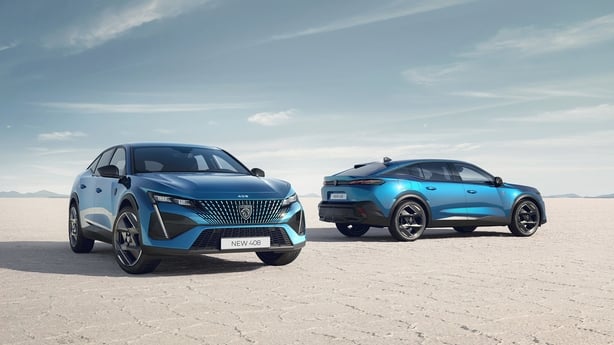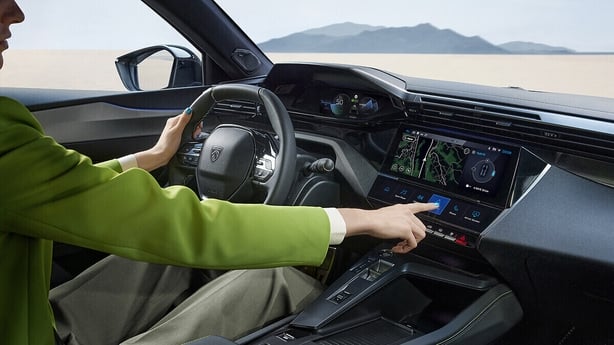There was a time when all cars fitted neatly into brackets. from mini to compact to family to executive and so on. However, in this age of crossovers and SUV lookalikes those boundaries have been blurred considerably.
In this context, it's interesting to see Peugeot - a company that now has all its customer bases covered and has had much success with SUV’s and crossovers - making such a statement with the launch of its new 408.
And the 408 is quite a statement. It’s long, low and angled all over - something of a hybrid between a hatchback and a coupe. Best perhaps to settle for the conventional term of fastback though, which is probably most appropriate here.
And in an era of sameness, the 408 does stand out.

At 4.69 metres long, the emphasis of the profile is sleek. It’s not all that often that you get a lot of people commenting on the design of a car but it happened me with the 408.
In some cases, it was actually the colour - Elixir Red - that seemed to generate the most interest. There are other exotically-named colours for the Peugeot range at the moment - Obsessive Blue being another rather striking example.
Unsurprisingly, there’s no diesel version of the 408 - something that will no doubt disappoint some drivers for whom big mileage diesel driving has been a hallmark of their Peugeot experience.
Currently there are two plug-in hybrid versions, both mated to an eight-speed automatic gearbox. A 1.2 petrol and 1.6 petrol are both options.
I drove the 1.6 litre GT version with a 180 horse power capacity and a 81 kW battery. Like most other plug-in hybrids it didn’t deliver the claimed 60 km range in EV mode. It was nearer 35 km, which is enough to accommodate commuting for many people but is still rather wide of the mark.
As one does these days, I chose the Eco mode for most of my driving and that is the mode that tends to highlight the issues when combing an automatic gearbox with hybrid driving - there’s a lag in response if you try to push the car in terms of acceleration.
A more gentle throttle approach delivers the best dividend in terms of fuel consumption and I managed to get 6.1 kilometres per litre of petrol on a mixed motorway and rural test.
There were also times when I managed to get down to 5.9. Both figures are very respectable and certainly not far behind what you will get from a good Peugeot HDi diesel. It should also be noted that the 408 PHEV is carrying an additional 300 kg in battery weight.
You might expect that this fastback design causes space issues and it does, but only in terms of the restriction imposed on headroom for those sitting in the back because of the sloping roofline.
The benefit of the overall size and length of the car is in terms of great legroom in the rear and more than enough space in the front for the driver and passenger. That sleek design does, however, mean entry and egress for taller drivers isn’t easy due to a raised floor sill.
The overall driving experience though was a good one. The 408 does not deliver as much as its styling promises, especially on secondary roads when things can get a bit soft in terms of handling, although the 19" wheels presented no issues.
In terms of comfort and low noise levels, the 408 has a lot of teach its rivals. I was struck, for example, by how quiet it was on on the motorway, with very little wind noise.

The interior is defined by Peugeot’s i-Cockpit, with a small flat-topped steering wheel. It's a divisive concept and people tend to love or hate it. I’ve gotten used to it over the last few years but, as a taller driver, it still presents issues in terms of getting the seating and steering wheel position right so you can actually read the instruments clearly.
The infotainment screen is adequately large and the graphics are excellent. However, I found the touchscreen functions hard to grapple with on occasion. A few times when I was inputting an address on the satellite navigation, I found myself back in the climate control zone, so sensitive are the touch functions. The scrolling speed can also be a bit too dramatic.
This isn’t helped when you are driving a right hand drive car that has been designed as a left hand drive. It’s counter-intuitive for most people to be using their left hand when the system is most easily managed by the right. That’s why I find the rotary control used by Audi and BMW a much better compromise and certainly less distracting.
The 408 comes in three versions that determine its specification level. The Allure starts at €39,995, the Allure Pack at €41,995 and the GT at €44,995. Standard equipment on all versions includes emergency braking, adaptive high-beam LED headlights, automatic cruise control and lane-keep assistance.
For the Peugeot diesel diehards, the new 408 need not be such a dramatic change. The economy of the hybrid system has significant benefits, even if the pure EV mode is not quite what it should be.


